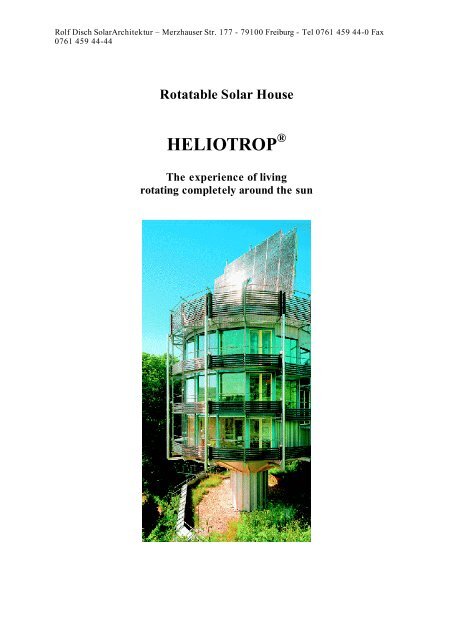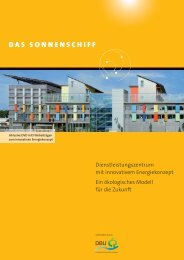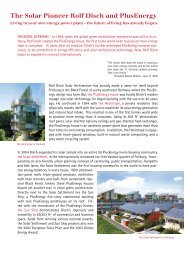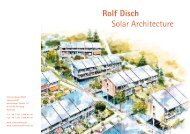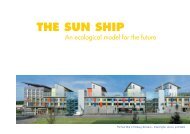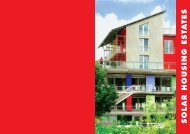Heliotrope - Rolf Disch
Heliotrope - Rolf Disch
Heliotrope - Rolf Disch
Create successful ePaper yourself
Turn your PDF publications into a flip-book with our unique Google optimized e-Paper software.
<strong>Rolf</strong> <strong>Disch</strong> SolarArchitektur – Merzhauser Str. 177 - 79100 Freiburg - Tel 0761 459 44-0 Fax<br />
0761 459 44-44<br />
Rotatable Solar House<br />
HELIOTROP ®<br />
The experience of living<br />
rotating completely around the sun
<strong>Rolf</strong> <strong>Disch</strong> SolarArchitektur – Merzhauser Str. 177 - 79100 Freiburg - Tel 0761 459 44-0 Fax 0761<br />
459 44-44<br />
The rotatable solar house HELIOTROP ® is not only a residential or studio building reflecting an<br />
exquisite taste, but also the demonstration how the most modern technologies which are available<br />
on the market can be used for energy saving and ecological purposes.<br />
HELIOTROP ® - House of the Future<br />
Conception and architecture of the HELIOTROP ® are the attempt of finding an answer to the<br />
challenges of our time. The most important aim is to bring together ecology, energy, economy and<br />
construction, technology and design - a contribution for high-quality living, for "house-keeping",<br />
for "lasting economical acting".<br />
The HELIOTROP ® is a solar power plant with floors in the top house of 180 m² A second living<br />
unit can be located in the basement. Dynamic simulations show a heating energy demand of only 21<br />
kWh/m², whereby the active solar systems being able to reduce the heating energy demand to zero<br />
are actually not considered.<br />
In addition the HELIOTROP ® is an energy-producing house which in regard to its own electric<br />
power consumption produces a multiple amount of electric power and supplies the exceeding<br />
amount to the public power supply system.<br />
Construction<br />
manufacturing<br />
All constructive, load-bearing parts of the "top house" are manufactured from the re-growing<br />
building material wood. All parts are industrially manufactured with CNC technologies. The largest<br />
pre-fabricated part is the central column with a height of 14 m and a diameter of 2,9 m. Meanwhile<br />
all rooms can be mounted in the factory, so that the house itself is built by connecting the segments<br />
to the central column. The effect of this manufacturing method is a low-cost serial production of<br />
HELIOTROPS: houses with exclusive living quality and depending on the lay-out with lowest, zero<br />
or even plus energy balance.<br />
Column<br />
The central load-bearing wood column containing the spiral stair has a diameter of 2,9 m and a<br />
height of 14 m. Since the HELIOTROP ® is world-wide the first building hanging at a load-bearing<br />
wood column a new calculation method for statics has been developed together with the Swiss<br />
2
<strong>Rolf</strong> <strong>Disch</strong> SolarArchitektur – Merzhauser Str. 177 - 79100 Freiburg - Tel 0761 459 44-0 Fax 0761<br />
459 44-44<br />
Technical University Zurich. As the only possible wood material veneered crosswise laminated<br />
wood, Kerto-Q, which is produced in Finland was identified.<br />
The column, as well as the building itself, is an eighteengonal construction. The 18 laminated wood<br />
sheets or boards have a semicircle shaped groove at the vertical longitudinal sides which are filled<br />
with epoxy resin in order to join the boards together. By means of ring-shaped steel ties which<br />
"surround the epoxy resin column" a very close join is obtained. The join strength in longitudinal<br />
direction of the edges is 90% of the wood strength, that is to say in the case of extreme stresses<br />
first of all steel and epoxy resin are deformed before the board itself is destroyed.<br />
The HELIOTROP ®<br />
as a Plus-Energy House<br />
Passive Solar Heating Systems<br />
Glazing/Thermal Insulation<br />
Glazing and thermal insulation make an essential contribution to the passive use of solar energy.<br />
The basement itself is a low-energy house. It is a conventional R.C. construction though with<br />
thermal insulation without heat bridges.<br />
Modern windows with heat absorbing glass - threefold heat absorbing glass with an k-value of 0.5 -<br />
contribute on the front side to the energy balance. The walls with a thermal insulation layer of 30<br />
cm are nearly heat-tight and the k-value is in the range of 0.1 - 0.13.<br />
Although the wintry heat losses of the windows are relatively high in comparison with the insulated<br />
walls, their insulating effect in summer may be disadvantageous because they retain heat in the<br />
room which may lead to over-heating. For this reason the inspection balconies - also to be used as<br />
fire escape ladders - are sunshades for the glass fronts during May, June and July when the sun is<br />
high in the sky so that only a small amount of solar radiation falls into the building.<br />
Rotation Mechanism<br />
The HELIOTROP ® is not the first rotatable building, but the first rotatable building using rotation<br />
in order to minimize the heating energy demand. Under normal conditions the building rotates for<br />
15° per hour following the sun.<br />
Active Solar Heating Systems<br />
Photovoltaic Power Supply System<br />
Size and Power output: On the roof of the HELIOTROP ® 54 m²of high-efficient monocrystalline<br />
silicon solar cells are installed allowing higher efficiency than most of the polycrystalline silicon<br />
solar cells. The solar panel has a two-axis solar tracking system turning around the horizontal and<br />
the vertical axis. The tracking system allows a 30 - 40 % higher energy gain than that of<br />
conventional, fixed plants. This is system is one of the largest, may be the largest photovoltaic<br />
power supply with two-axis solar tracking system in Germany.<br />
Public network and input: Surplus of the photovoltaic power supply system is supplied to fixed<br />
prices to the public network of Freiburg which is on the other hand the electric power supplier as<br />
soon as solar insolation is not sufficient to operate the whole plant. In that way the network is used<br />
as a store. This is from the ecological point of view a reasonable solution because available electric<br />
3
<strong>Rolf</strong> <strong>Disch</strong> SolarArchitektur – Merzhauser Str. 177 - 79100 Freiburg - Tel 0761 459 44-0 Fax 0761<br />
459 44-44<br />
batteries use heavy metals which have to be disposed in a proper way. Further network supply<br />
guarantees higher system efficiency.<br />
Some investigations show that a supply amount to the public network of 20% by renewable energy<br />
sources for electric power generation is possible without problems. An amount which is actually far<br />
away to be reached.<br />
The yearly power output of the plant will be in the range of 9.000 kWh. This is approx. five times<br />
the amount of the building's electric power consumption.<br />
Hot-Water Evacuated Tube Collectors<br />
At the inspection balconies evacuated tube collectors are installed as railing elements. They produce<br />
hot water for the building. For hot water heating for domestic use 6 m² collector surface would have<br />
been sufficient for a 100 % solar fraction during the summer months. For the HELIOTROP ® 31,5<br />
m²have been installed in order to use solar heat for space heating. The heated water is supplied to<br />
the storage tanks in the service rooms.<br />
Installations/Heating Systems<br />
Dynamic simulations show a heating energy demand of 47 kWh/m² for the basement and of 21<br />
W/m² for the top house.<br />
(Earth) Heat Exchanger<br />
One of the heat exchangers is located in the service room of the basement. It supplies the active<br />
ventilation system of the basement. The principle is very simple: energy of the outgoing air is<br />
transferred to the cool supply air which leads to a reduction of energy losses by the ventilation<br />
system. The ventilation of the top house is the same principle whereby the heat exchanger is<br />
located in the service room of this building part. This kind of controlled ventilation with heat<br />
recovery bases on the principle of air heating. In addition air can be led through the earth heat<br />
exchanger which is located in the slope behind the basement. In summer the supply air is precooled,<br />
in winter if the earth temperature, similar to the summer, is in the range of 8°C, the air is<br />
pre-heated. The air is then led through the heat exchangers and is finally heated up in the solar<br />
store to comfortable room temperatures.<br />
Floor Heating System<br />
The 65 mm thick screed layer as well as the water in the floor heating system are used for heat<br />
storage of solar energy falling through the windows into the room and being absorbed by the floor.<br />
Low-temperature heating systems have the advantage that they can easily be used in winter<br />
together with thermal solar plants. In winter such collectors do not reach the summery peak<br />
temperatures which may exceed 100°C. For low-temperature heating systems temperatures of about<br />
30°C are sufficient. A value which can easily be reached with collectors plants in winter. A floor<br />
heating system is a thermally inert system, because the energy amount required for heating is<br />
relatively high. They are not suitable for quick space heating but mainly as a stand-by system for<br />
space pre-heating. The floor heating system of the HELIOTROP ® allows independent control of<br />
all rooms which makes it possible to pump solar heat from the side facing the sun to the opposite<br />
side of the building.<br />
Low-Temperature Ceiling Radiation System<br />
The low-temperature ceiling radiation system is a quick-acting heating system. As soon as hot<br />
water is pumped into the system the heating surfaces - a strip system - are heated up quickly and<br />
4
<strong>Rolf</strong> <strong>Disch</strong> SolarArchitektur – Merzhauser Str. 177 - 79100 Freiburg - Tel 0761 459 44-0 Fax 0761<br />
459 44-44<br />
give off heat in form of radiation heat by means of 37 m²surfaces in the building. Since the<br />
radiators are mounted at the ceiling they give off only a little amount of heat to the air. This also<br />
not intended because comfortable conditions shall be effected by radiation heat.<br />
This quick-acting system allows lower stand-by temperatures in the rooms than for conventional<br />
residential buildings. Comfortable room temperature (only when the room is used) can be ensured by<br />
radiation heat which reduces the energy demand for space heating.<br />
Similar to the floor heating system the flow temperature is 45°C max. which is suitable for a<br />
combination with solar collector plants.<br />
Waste Concept / Conserving Resources<br />
Waste Water<br />
A dry compost toilet ensures that waste water of the house is kept without faecal matters which<br />
allows pre-cleaning without disturbances by smell outside the building. In two seepage basins located<br />
one above the other mechanical and chemical purification is carried out. By means of a cascade the<br />
water is enriched with oxygen and flows then into a small pond where the water quality is good<br />
enough for gold-fishes to live there. Pumping the water into a grey-water well where rainwater is<br />
also collected it can re-used (for example in the washing-machine).<br />
Faecal Matters, Organic Wastes<br />
The ecotoilet of the top building is used for composting faecal matters and organic kitchen wastes.<br />
In the composter located in the service room the wastes to be decomposed are dehydrated<br />
biologically. The result is an odourless, mass-reduced dry matter. Only once per year 40 litres of dry<br />
compost have to be taken from the composter.<br />
The toilet itself works without water flushing and consists mainly of a stainless steel downpipe.<br />
Also the kitchen wastes are led directly from the kitchen into the composter over a downpipe.<br />
Site, Sealed Ground<br />
At first the ground on which the house is located was planned not to be built-up, because it was a<br />
part remaining at a slope. The kind of the house built on this ground makes it to a top ground. A<br />
specific advantage of the building is, that remaining parts on slopes which could not be used<br />
otherwise or small sites - the HELIOTROP ® ground is 512 m²- are enhanced to the status of<br />
excellent sites.<br />
Due to the thin trunk of the building the terrace place can be used twice. On the site it self and in<br />
form of the roof garden with 60 m².<br />
5
<strong>Rolf</strong> <strong>Disch</strong> SolarArchitektur – Merzhauser Str. 177 - 79100 Freiburg - Tel 0761 459 44-0 Fax 0761<br />
459 44-44<br />
HELIOTROP ® - Flat Floor Space and Floors<br />
Flat Floor Space and Floors m 2<br />
Top house<br />
Flat floor space 90.83<br />
Seminar and working rooms<br />
incl. 60 m²2 roof garden 117.83<br />
Overall 208.66<br />
Basement<br />
Exhibition, seminar and office room 77.21<br />
Overall top house and basement 285.87<br />
In this space not contained<br />
Service and store rooms 40<br />
and<br />
Stair floors, Entrance of top house, Balconies<br />
Auxiliary spaces<br />
Ground of the HELIOTROP<br />
prototype 512<br />
Covered by the top house, planted and usable space<br />
(Projection space) 90<br />
Ground covered and "sealed" by the trunk 9<br />
Construction / Technical Layout<br />
The HELIOTROP ® Freiburg consists of the basement as the foundation, the rotatable tower and a<br />
"solar sail".<br />
Tower<br />
rotatable about 400°<br />
electric motor<br />
120 W<br />
yearly power consumption only<br />
20 kWh<br />
external diameter<br />
10,5 m<br />
heated space tower 180 m²<br />
6
<strong>Rolf</strong> <strong>Disch</strong> SolarArchitektur – Merzhauser Str. 177 - 79100 Freiburg - Tel 0761 459 44-0 Fax 0761<br />
459 44-44<br />
Column<br />
internal diameter<br />
2.6 m<br />
height<br />
14.5 m<br />
mass incl. technical appliances and stair<br />
15 t<br />
wall thickness<br />
111 mm<br />
from 18 Kerto Q-boards (produced in Finland) The joints of the longitudinal edges are carried out<br />
with steel ties filled up with epoxy resin.<br />
Modules<br />
Room cells connected in spiral form to the column. To be entered from the trunk or the neighbour<br />
elements.<br />
Solar panels with two-axis tracking system<br />
aperture space 54 m²<br />
peak load<br />
6.6 kW p<br />
Safety engineering / Strength<br />
In order to take into account all possible load scenarios the following maximum stresses have been<br />
considered in the column footing:<br />
Normal stresses<br />
Own weight, imposed load,snow load<br />
Bending moments<br />
Wind load on the building and solar platform and un-equal load distribution<br />
1700 kN<br />
1850 kNm<br />
Torsion moments<br />
Asymmetric wind loads on the building and the solar platform<br />
55 kN<br />
Swing<br />
Maximum swing at the top of the column25 mm<br />
For the maximum bending moment of 18050 kNm two pictorial examples can be found:<br />
≅ At the HELIOTROP ® a free cantilever bar of 2,7 km length is fixed; on the free end a<br />
person of 70 kg weight is sitting.<br />
400 people are standing at the same side of the tower and look out of the window.<br />
Ecology<br />
The HELIOTROP ® fulfils ecological requirements.<br />
Building materials<br />
Wood, Kerto Q-Boards from Finland, wood framework in BSB technique, steel<br />
Thermal insulation<br />
Wall, roof and floor insulation k-value 0.10 - 0.13<br />
Windows with three-fold heat protection glass<br />
(average value incl. frame) k-value 0.6<br />
Glass with Krypton filling k-value 0.5<br />
7
<strong>Rolf</strong> <strong>Disch</strong> SolarArchitektur – Merzhauser Str. 177 - 79100 Freiburg - Tel 0761 459 44-0 Fax 0761<br />
459 44-44<br />
Glass with Xenon filling k-value 0.4<br />
Heat<br />
Rotatable tower - heating or cooling with sun and shade. Evacuated tube collectors at the railing for<br />
hot water heating for space heating and domestic use, water store and latent heat store, earth heat<br />
exchanger for supply air<br />
Wastes/faecal matters<br />
decomposed<br />
Water/rainwater<br />
collected on the roof<br />
Waste water<br />
Water purification in two plant clarifying basins and a pond as collecting pond in the garden in<br />
order to use the water for clothes washing and rinsing.<br />
Covered area<br />
is compensated by planting of the roof surfaces of the basement and the tower.<br />
8


